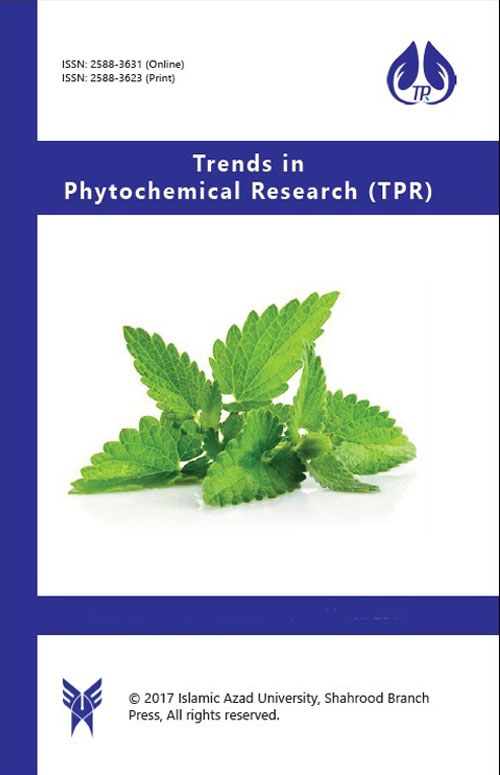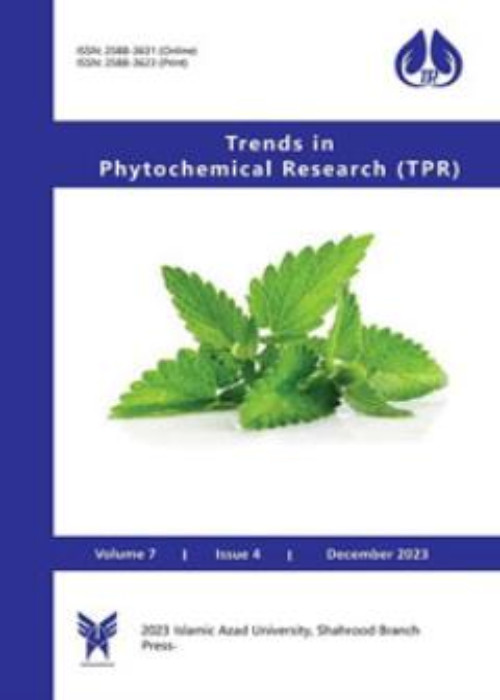فهرست مطالب

Trends in Phytochemical Research
Volume:5 Issue: 4, Autumn 2021
- تاریخ انتشار: 1400/10/05
- تعداد عناوین: 6
-
-
Pages 166-167‘Gandho badali’ (Paederia foetida L.), a well-known medicinal plant from the family Rubiaceae with a fetid smell, is indigenous to Bangladesh, but also native to several other South- and Far-Eastern Asian countries like Bhutan, Cambodia, China, India, Indonesia, Japan, Laos, Malaysia, Nepal, South Korea, Taiwan and Vietnam. In addition to the Bengali name ‘Gandho badali’, this perennial climber is also commonly known as ‘Gandhobadulia’, ‘Kings tonic’, ‘Skunkvine’, ‘Stinkvine’ an ‘Chinese fever vine’. Phytochemical investigations on this plant established the presence of alkaloids, anthraquinones, coumarins, iridoids, lignans, phenolics, steroids and terpenoids. Aizarin, asperuloside, campesterol, 1,3-dihydroxy-2-methoxyanthraquinone, digiferrol, ellagic acid, epifriedelinol, friedelin, lupeol, morindaparvin A, paederoside, paederosidic acid, sitosterol, stigmasterol and ursolic acid are the major secondary metabolites found in various parts of P. foetida.Keywords: Ayurvedic medicine, ‘Gandho badali’ (Paederia foetida L.), Paederoside, Rubiaceae, Traditional medicine
-
Pages 168-189
Species of the genus Siparuna Aublet are found in Neotropical regions, mainly in the Andes. In the Brazilian folk medicine, some Siparuna species are used to combat fever, inflammation, pain, and infections. This paper presents a review of phytochemical studies and biological activities of species of this genus. Phytochemical studies of 18 species led to the isolation of mainly flavonoids (quercetin and kaempferol derivatives) as well as alkaloids (aporphinic derivatives). Essential oils were reported for 8 species among which S. guianensis is the most studied species. Numerous reports provide evidence of antimicrobial, antiplasmodic, larvicidal, cytotoxic, and antioxidant activities for some species of Siparuna genus. The reports of phytochemical studies and biological activities motivate the continued research of other species of the genus, remembering that a large part of the identified species are unknown from the natural products chemistry point of view.
Keywords: Antibacterial, Antioxidant, Essential oils, Pharmacological activities, Phytochemistry, Secondary metabolites -
Pages 190-198
The roots of the plant Wikstroemia indica (L.) C.A. Mey., also known as Radix Wikstroemiae or Liaogewanggen in China, are used in traditional medicine as decoctions for the treatment of diverse inflammatory diseases, such as arthritis, bronchitis, and many other conditions. A large diversity of bioactive natural products have been characterized in W. indica including flavonoids, lignans, coumarins and sesquiterpenes. A scoping review was designed to identify the variety of biflavonoids isolated to date from the plant (mostly but not exclusively from the roots) and to depict their mode of action, based on database retrieval and a detailed analysis of all the relevant scientific literature. A focus has been made on two important series of C-3 linked dimeric compounds, sikokianins and wikstroflavones, and their anticancer properties and mechanism of action. Sikokianins A-D are atypical C-3/C-3’’ biflavonoids, with sikokianin C as a lead molecule acting as an inhibitor of cystathionine β-synthase (CBS) and exhibiting marked anticancer properties in vivo. Wikstroflavones A-B and wikstaiwanones A-B are unusual flavone/ flavanol dimers with a C-3/C-6'' linkage. Wikstroflavone B can potentiate the antiproliferative and antimetastatic activity of anticancer products. A few other biflavonoids have been isolated from the rhizomes of W. indica, such as daphnodorin derivatives. A biflavonoid-oriented survey of Wikstroemia indica is provided to highlight the potential benefit of the roots of Wikstroemia indica for the treatment of cancer.
Keywords: Biflavonoids, Cancer therapeutics, Phytotherapy, Roots, Wikstroemia indica (L.) C.A. Mey -
Pages 199-208
In this work, 22 Damask rose accessions were cultivated in a randomized complete block design with 3 replications. Then, chemical components of essential oils (EOs) were identified and subsequently characterized using gas chromatography (GC) and gas chromatography mass spectrometry (GC/MS) techniques. Accordingly, sixteen chemical compounds were identified, which accounted for about 85.3-99.8% of the EOs. Accessions were classified in 4 groups by cluster analysis. Discriminant function analysis (DFA) was found to be in line with the results of cluster analysis approach. In addition, using principal component analysis (PCA), the first 5 components had Eigen values higher than 1. n-Eicosane, n-heneicosane, n-tricosane, n-nondecane and n-tetradecanal had maximum portions in first component, while citronellyl acetate, geranial and n-undecanol had the maximum portions in the second component. Accessions of Isfahan5, Kermanshah5 and Kermanshah6 had the maximum percent of geraniol and citronellol, the two key chemical components, responsible for EO quality.
Keywords: Cluster analysis, Damask rose, Discriminant function analysis (DFA), Essential oil, GC, MS, Principal components analysis (PCA) -
Pages 209-221In the present study, we investigated the safety and therapeutic efficacy of arq ajwain (AA) against nonalcoholic fatty liver disease (NAFLD) on a high-fat diet (HFD) induced obese rat model. After 4 weeks of the treatment, AA (4 mL/kg, twice a day) and AA1 (7.75 mL/kg, twice a day) treatments reduced body weight, serum triglycerides (TG), total cholesterol (TG), glucose, insulin, leptin, pancreatic lipase activity and alanine aminotransferase (ALT) levels (p < 0.001). AA, AA1, and thymol (T) treatments also decreased lipids (TG and TC) levels and increased thiobarbituric acid reactive substances (TBARS), superoxide dismutase (SOD), and catalase (CAT) levels in hepatic tissue (p < 0.001). Moreover, treatment groups considerably reduced hepatic inflammation, steatosis, hepatocellular ballooning, and fibrosis. These results recommend that arq ajwain has a strong protective effect against NAFLD in HFD induced obese rat models.Keywords: Ajwain, insulin, Leptin, Nonalcoholic fatty liver disease, Oxidative stress
-
Pages 210-217Tetrataenium nephrophyllum belonging to the Apiaceae family grows widely in the West Azerbaijan province of Northwestern Iran. It is an aromatic plant that has been used as food spices by local people. In this research work, the phytochemical composition of n-hexane extract from the aerial parts of this plant has been investigated. The fractionation of the n-hexane extract by normal phase column chromatography resulted in the isolation, purification, and identification of five compounds. The structural elucidation was accomplished by extensive spectroscopic methods, including 1D and 2D NMR experiments (1H-NMR, H-H-COSY, HSQC, HMBC, and NOESY) as well as ESI-MS analysis. The isolated compounds were 5-geranyloxycoumarin (1), isobergapten (2), pimpinellin (3), β-sitosterol (4) and dammara- 20,23-dien-3β,25-diol. The acetylcholinesterase inhibitory activity of the isolated compound was evaluated by experimental and molecular docking methods. Compound 3 showed the best acetylcholinesterase inhibitory with an IC50 value of 0.208 μM and docking score of -7.5 kcal/mol.Keywords: Apiaceae, coumarin, Molecular docking, Phytochemical profiling


